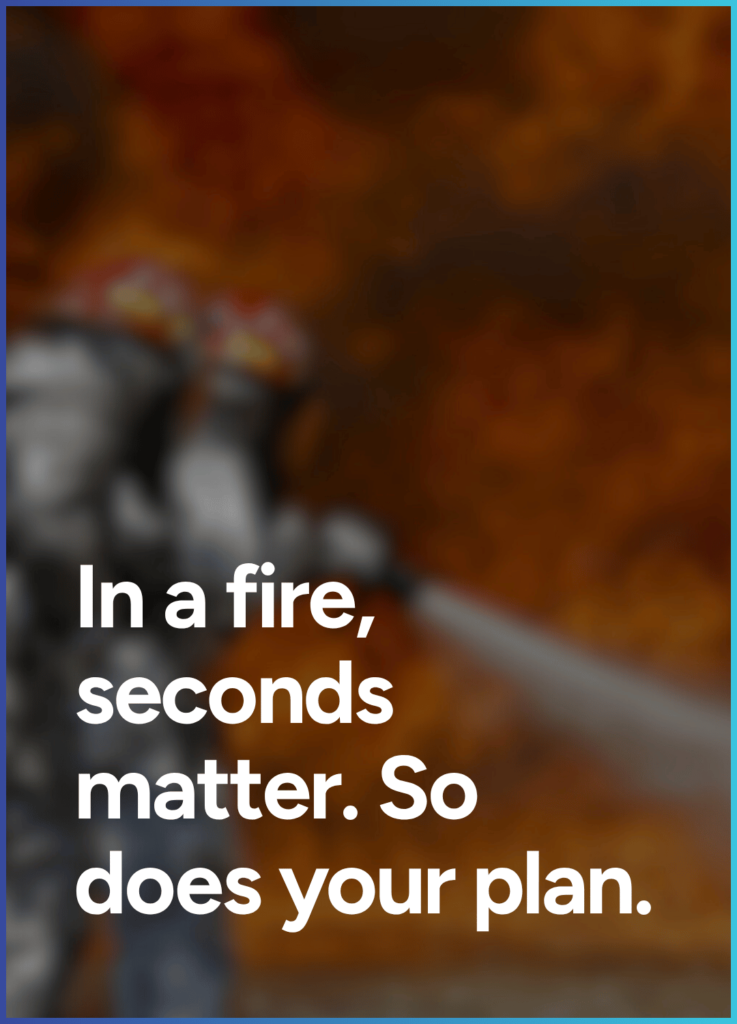October 6, 2025
Fire Safety at Work: Why Exit Plans Aren’t Just Boring Maps on the Wall

October 6, 2025


Picture this: You’re sitting at your desk, coffee in hand, mid-email rant, when suddenly that high-pitched alarm blares. Not your inbox notification. The other one. The fire alarm.
Do you know where to go? Or are you going to follow Steve from accounting because he seems confident (spoiler: Steve’s leading everyone straight to the locked storage closet)?
That’s why we need to talk about workplace fire safety and egress plans. And before you roll your eyes thinking, “Ugh, drills and laminated maps,” let me stop you. This isn’t just about ticking a compliance box. It’s about protecting people, saving lives, and making sure your business doesn’t go up in flames, literally and figuratively.
Every October, Fire Prevention Week sneaks up, reminding us that flames don’t wait for convenient times. They don’t care if you’re two minutes from clocking out or if you finally just heated your lunch. Fires move fast, smoke disorients even faster, and chaos spreads quicker than a juicy office rumor.
And yet, too many workplaces treat fire safety like the awkward safety video HR made everyone watch in 1999. Outdated, ignored, and gathering dust. The reality? Two-thirds of adults with substance use disorder are employed (yep, that CDC stat), and a scary number of working adults also have no clue what to do in a fire emergency.
So let’s fix that.
Think of it as your office’s fire escape script. Everyone has a role, everyone knows their line, and the goal is the same: get out alive and safe.
It’s made of two parts:

Safety first, always. Your people want to know you’ve thought about their safety, not just their productivity.
Morale booster. Believe it or not, practicing fire drills right can build trust and calm. (If middle school could make them cringe-worthy, you can make them empowering.)
Protecting your business. Fires don’t just burn walls and ceilings. They torch productivity, morale, and your brand if you’re not prepared.
Compliance brownie points. OSHA doesn’t just “suggest” you have an emergency action plan, they require it. And fines don’t look good in a budget meeting.
Here’s how to build a fire safety culture without putting your team to sleep:
Safety doesn’t have to be fear-based. It can be confident, practical, and yes, even a little fun. If you only think about fire safety once a year, you’re doing it wrong. A culture of safety means:
Regular reminders in staff meetings.
Visual cues (signs, maps, clearly visible extinguishers).
Leaders modeling the right behavior during drills.
Making it part of onboarding, not an afterthought.
Leaders often freeze because they’re afraid of saying the wrong thing. Or they overcomplicate it with jargon nobody remembers under stress. Here’s the truth:
Your people don’t need perfection. They need clarity.
Compliance is the floor, not the ceiling. The real win is when employees feel cared for.
Leadership is about courage, not checklists. Taking fire safety seriously shows you value lives over bottom lines.

We’ve put together a free Workplace Fire Safety & Egress Plan you can download and customize for your workplace. It’s not just a stack of compliance boxes to tick, it’s a lifeline that helps protect your people and your business when seconds matter most.
A plan on paper is good, but a plan your team actually understands and practices? That’s leadership. Take the first step, download it today and make sure safety isn’t left to chance.
Plans are powerful, but people make them work. That’s where HAZWOPER Fire Safety Training: Prevention and Response comes in. This course equips your team with the knowledge and confidence to spot hazards, prevent fires before they spark, and respond calmly if one does break out. From safe handling of hazardous materials to proper extinguisher use, your employees walk away not just trained, but empowered. It’s prevention plus response, woven into your workplace culture. Investing in training isn’t just about compliance. It’s about giving your people the tools to protect themselves and each other.
Workplace fire safety isn’t about scaring people. It’s about showing them you’re prepared, you care, and you’ve thought ahead. Fires don’t have to end in tragedy if prevention and egress plans are taken seriously.
So the next time you walk past that EXIT sign, don’t let it fade into the background like old wallpaper. That glowing green arrow is more than compliance. It’s a promise: If something goes wrong, we’ve got a way out, together.
And hey, if you can turn fire drills from eye-roll material into something your team actually respects (and maybe even laughs about after), you’ve already won.
References
Occupational Safety and Health Administration (OSHA) – Emergency Preparedness and Response
National Fire Protection Association (NFPA) – Basics of Means of Egress Arrangement
Centers for Disease Control and Prevention (CDC) – Emergency Preparedness

